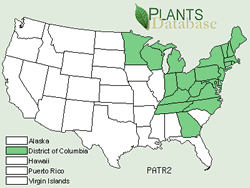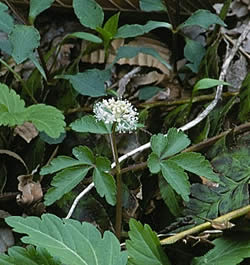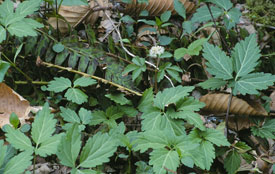Plant of the Week
 Range map of dwarf ginseng, Panax trifolius.
Range map of dwarf ginseng, Panax trifolius.
 Dwarf ginseng, Panax trifolius. Photo by Gary Kauffmann.
Dwarf ginseng, Panax trifolius. Photo by Gary Kauffmann.
Dwarf ginseng (Panax trifolius L.)
By Clare Hydock
Dwarf ginseng is a member of the Araliaceae (Ginseng) family. This family contains trees, shrubs, vines or herbs with sometimes simple but usually compound leaves, and small flowers in umbels or head-like clusters. Flowers of dwarf ginseng are tiny (about two millimeters wide), dull white umbels rising from a whorl of three compound leaves. In botanical Latin trifolius means "three leaves". It flowers from April to June followed by yellowish, clustered berries in July to August. The plant reaches 10 to 20 centimeters in height (4 to 8 inches).
Dwarf ginseng is found in moist woods and damp clearings from Ontario, Canada east to Nova Scotia, south to Georgia and northwest to Kentucky, Indiana, and Minnesota. It looks like a small version of American ginseng (P. quinquefolius), but can be distinguished by its three nearly sessile leaflets versus the five, stalked leaflets of American ginseng.
American Indians used tea of the whole plant for colic, indigestion, gout, hepatitis, hives, rheumatism, and tuberculosis. The root was chewed for headaches, shortness of breath, fainting, and nervous debility. Its distinctive tubers can be eaten raw or boiled.



